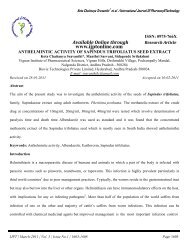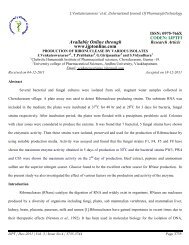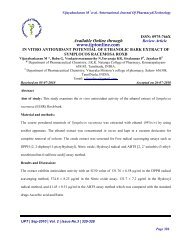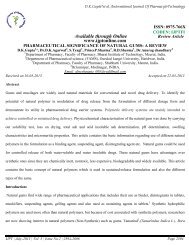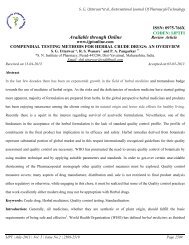ISSN: 0975-766X CODEN: IJPTFI Available through Online Review ...
ISSN: 0975-766X CODEN: IJPTFI Available through Online Review ...
ISSN: 0975-766X CODEN: IJPTFI Available through Online Review ...
- No tags were found...
Create successful ePaper yourself
Turn your PDF publications into a flip-book with our unique Google optimized e-Paper software.
This yields an overall cell reaction of:Vijay. K * et al. /International Journal Of Pharmacy&Technology2Pb + 4 OH 2PbO + 2H 2 O + 4e -2Pb + O 22 PbOFuel cell oxygen sensors are current generators. The amount of current generated is proportional to theamount of oxygen consumed (Faraday's Law). Oxygen reading instruments simply monitor the current output of thesensor. An important consideration is that fuel cell oxygen sensors are used up over time. In the cell reaction above,when all available surface area of the lead (Pb) anode has been converted to lead oxide (PbO), electrochemicalactivity ceases, current output falls to zero, and the sensor must be rebuilt or replaced. Fuel cell sensors are designedto last no more than one to two years. Even when installed in an instrument which is never turned on, oxygen sensorswhich are exposed to atmosphere which contains oxygen are generating current, and beingused up. Oxygen sensors are also influenced by the temperature of the atmosphere and are being useto measure. Thewarmer the atmosphere, the faster the electrochemical reaction.For this reason oxygen sensors usually include a temperature compensating load resistor to hold currentoutput steady in the face of fluctuating temperature. Another limiting factor is cold. The freezing temperatureof electrolyte mixtures commonly used in oxygen sensors tends to be about 5 o F (- 20 o C). Once the electrolyte hasfrozen solid, electrical output falls to zero, and readings may no longer be obtained. There are two basic variations onthe fuel cell oxygen sensor design. These variations have to do with the mechanism by which oxygen is allowed todiffuse into the sensor. Dalton's Law states that the total pressure exerted by a mixture of gases is equal to the sum ofthe partial pressures of the various gases. The partial pressure for oxygen is that fraction of the total pressure due tooxygen. Partial atmospheric pressure oxygen sensors rely on the partial pressure (or pO 2 ) of oxygen to drivemolecules <strong>through</strong> the diffusion barrier into the sensor.As long as the pO 2 remains constant, current output may be used to indicate oxygen concentration. On theother hand, shifts in barometric pressure, altitude, or other conditions which have an effect on atmospheric pressurewill have a strong effect on pO 2 sensor readings. Since there is less force driving oxygen molecules <strong>through</strong> theIJPT | Dec-2011 | Vol. 3 | Issue No.4 | 1709-1723 Page 1714



